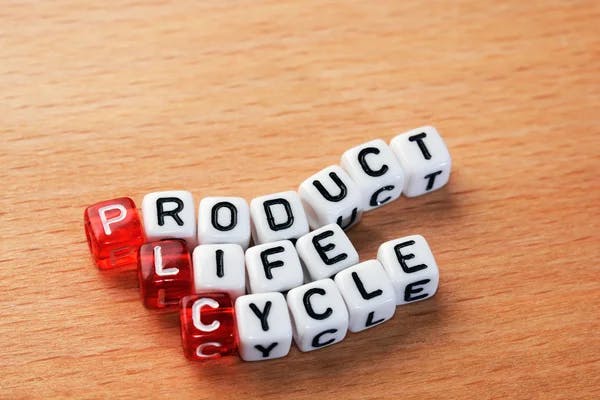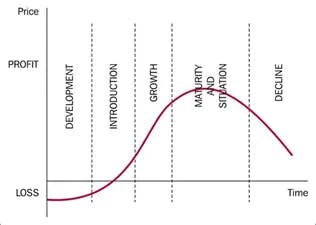A product's life cycle is the period of time from when it is initially made available to consumers until it is discontinued. The product life cycle, in other words, outlines the stages that a product is likely to go through. Managers can use it to examine their products and create plans as they move through different stages.
Professionals in management and marketing use product life cycles to assist them decide on advertising schedules, price points, expanding into new product markets, redesigning packaging, and more. Product life cycle management refers to these strategic means of a product's support. They can also aid in predicting when fresher goods will begin to supplant older ones on the market.

Examples of product lifecycles
Introduction phase (Self Driving Cars):
Despite the fact that self-driving cars are still in the testing phase, companies anticipate being able to sell to early adopters rather soon.
Growth phase (Tesla Model S):
The Tesla Model S is currently seeing growth. People still need to be persuaded that electric automobiles are reliable and useful. It gets simpler to persuade individuals who are more skeptical of new technology, like electric automobiles, as there are more electric charging sites and more people use them.
Maturity (Ford Focus): The Ford Focus is a well-known automobile. It has attained its highest level of market penetration and has a positive brand reputation. It would be challenging to increase your market share significantly. To keep the Ford Focus at the top of the market, updates and redesigns have been made frequently, extending the product life cycle.
Decline (Diesel Vehicles): Since the degree of pollution from diesel cars has alarmed governments. In a few years, several cities may outlaw diesel vehicles. Sales have significantly decreased, and the market for diesel vehicles may be nearing its end.
Stages of Product Life Cycle

The six stages of a product's life cycle are typically identified as Development, Introduction, Growth, Maturity, Saturation, and Decline.
1. Development
Before a product is released onto the market, there is a research period known as the development stage of the product life cycle. During this time, businesses recruit investors, create prototypes, evaluate the performance of their offerings, and plan their launches. Due to the nature of this stage, businesses invest a significant amount of money without seeing any return because the product hasn't yet been marketed. Depending on the intricacy of the product, how fresh it is, and the level of competition, this stage may last a considerable amount of time. The development phase for a brand-new product is challenging because its initial iteration is frequently less effective than subsequent iterations.
2. Introduction
When a product is first introduced to the market, it is in the introduction stage. At this point, marketing departments start cultivating brand awareness and contacting prospective clients. A product's first sales are often low, and demand increases gradually. This stage typically focuses on marketing and advertising campaigns. Businesses test different distribution methods and make an effort to inform potential clients about their products. The most famous launch presentations of Apple's (AAPL) products, which highlight the new features of their just released (or upcoming) products, may be the best example of this. The corporation is now able to gauge how people will react to the product, whether they will enjoy it, and how successful it might be. The main objectives of the introduction phase are to increase consumer demand for the product and get it into their hands in order to profit later on from its escalating popularity.
3. Growth
Consumers have accepted the product on the market and are starting to genuinely buy in during the growth stage. That indicates that both demand and profits are rising, preferably consistently and quickly. The market for the product is expanding during the expansion stage, and competition is starting to emerge. As they observe your success, potential rivals will want to join you. The corporation may continue to make significant investments in product advertising and marketing if competition for the product is particularly fierce. The market tends to grow as a result of the expanding product. During the development phase, products are frequently modified to enhance their capabilities.
4. Maturity
When sales reach their maturity stage, they start to slow down after a period of strong expansion. At this stage, businesses start lowering their prices in an effort to remain competitive against the escalating competition. During this stage, a company starts to improve its efficiency and learn from its errors from the launch and growth phases. Typically, marketing strategies prioritize differentiation above awareness. This implies that product features might be improved, costs could be decreased, and distribution could get more involved. Products start to move into the most lucrative stage as they mature. While sales are rising, production costs are falling.
5. Saturation
During the product saturation stage, rivals have started to take market share, and sales of the products won't increase or decrease. The majority of people typically use a product at this point, however there are numerous rival businesses. In order to avoid moving into the decline stage at this point, you want your product to overtake the competition.
6. Decline
Unfortunately, you'll usually see a fall if your product doesn't establish itself as the top brand in a given area. Even though businesses typically try to prolong the life of their product as long as possible, almost all products eventually go into decline. Sales will suffer as a result of the increased competition.
Key Takeaways
Making decisions based on the life cycle stage is possible with product life cycle management.
- Boost return on investment for product launches
- Boost business profitability
- Adjust your marketing messages proactively to maintain contact with your target markets.
- Maintain and enhance the allure, standing, and devotion of the product
Those who don't properly manage a product life cycle will experience negative effects like:
- The product's failure to live up to its potential
- Diminished shelf life
- Surplus inventory
- Loss of earnings
- Entering the market downturn stage too soon

